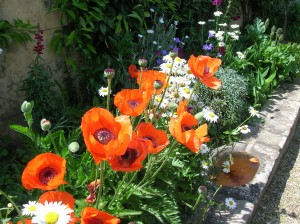Other Name
Compact Oriental poppy
Sun Requirements
full sun, part sun
Bloom Period and Seasonal Color
Spring to early summer in colors such a red, orange, salmon, white and bi colors
Mature Height x Spread
2 to 4 feet x 2 feet
Added Benefits
attracts beneficials, deer resistant
Oriental poppies produce large, colorful flowers early in the growing season that stand 2 to 4 feet tall perched on sturdy stems. They like our cool New England summers. The silky textured flowers can be up to 6 inches wide, making a dramatic statement when in bloom. Unlike the seed grown, smaller poppy types, such as California poppies, bread seed poppy, and Flanders poppy, the Oriental poppy is a true perennial. The mother plant returns each year and slowly expands over time to produce a larger plant and more flowers. The only downside of Oriental poppies is they die back in summer, so are best planted in a garden with lots of other summer bloomers to fill in the gaps left by the Oriental poppy.
Where, When and How to Plant
Oriental poppies are hardy throughout New England. You can grow Oriental poppies from seed started indoors under grow lights. The poppies resent being transplanted, so grow them in biodegradable pots that can be planted directly into the garden. An easier way to get started with Oriental poppies is to purchased plants from a local garden center and plant from early spring into early summer. Oriental poppies flower best in full or part sun on well-drained, fertile soil. Dig a good-sized hole for your transplant since it has a taproot. Amend the planting hole with compost and space plants 1 to 2 feet apart.
Growing Tips
Oriental poppies will flower early and then the plant will die back. The plant will reemerge in late summer, but not flower again. Amend the soil annually in spring with compost. Even though Oriental poppies can be drought tolerant once established, keep young plants well watered.
Regional Advice and Care
Protect plants in spring from slugs and snails with beer traps, iron phosphate organic bait, and sharp sand or crushed seashells. Cut back the foliage of the poppy plant to the ground once it starts to yellow in early summer. You can deadhead spent flowers, or leave the flowers to form seedpods that are attractive in their own right. Oriental poppies don’t divide well because of their taproot. If you must move your plant, so do in fall and try to dig a deep hole to remove as much of the taproot as possible.
Companion Planting and Design
Plant Oriental poppies in the middle or back of the flower border to let other flowers fill in once they die off. Hide the withering poppy foliage with summer blooming perennials such as Siberian iris, baby’s breath, Russian sage, daylilies and rudbeckia. Protect the new poppy foliage in fall with bark mulch or pine boughs.
Try These
“Watermelon” is a dwarf, 2-foot variety with salmon-pink flowers. “Patty’s Plum” has reddish-purple colored flowers. “Doubloon” has bright orange flowers and “Forncett” has frilly pink petals. “Royal Wedding” features white flowers with a dark purple center.
Excerpted from my book, New England Getting Started Garden Guide.



